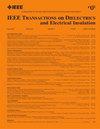A Generating Method for UHF Maps of Epoxy Surface Discharge Based on the Multiscale Simulation System
IF 3.1
3区 工程技术
Q2 ENGINEERING, ELECTRICAL & ELECTRONIC
IEEE Transactions on Dielectrics and Electrical Insulation
Pub Date : 2025-02-07
DOI:10.1109/TDEI.2025.3540000
引用次数: 0
Abstract
The ultrahigh-frequency (UHF) maps are often used as an important basis to evaluate the insulation status. However, the current research is mostly driven by pure data, making it difficult to judge the actual status of defects through UHF maps. Multiscale simulation technologies are adopted to simulate the UHF maps of surface defects from physical mechanisms. The microprocess of surface discharge is simulated using the plasma model, and the electromagnetic (EM) signal amplitudes are calculated based on the finite-difference time-domain (FDTD) method, using the current in the microsimulation as an excitation. Then, the segmented equivalent parameters of the circuit model are solved using the microsimulation results. The phases of the UHF pulses are simulated in the circuit model, and the UHF maps are obtained combined with the signal amplitude. It is found that the undischarged segment resistance determines the voltage recovery time, which is a key parameter that affects the UHF maps. The random settings of the simulation are important factors making the simulation results more reasonable. The relationship between the microprocess of surface discharge and the UHF maps is established theoretically, providing a basis for the accurate assessment of the insulation defect status of power equipment.基于多尺度仿真系统的环氧表面放电超高频图生成方法
超高频(UHF)图经常被用作评估绝缘状态的重要依据。然而,目前的研究大多是由纯数据驱动的,很难通过UHF图来判断缺陷的实际状态。采用多尺度模拟技术,从物理机制上模拟表面缺陷的超高频图。采用等离子体模型模拟了表面放电的微过程,利用微模拟中的电流作为激励,基于时域有限差分法计算了电磁信号的幅值。然后,利用微仿真结果求解电路模型的分段等效参数。在电路模型中模拟了超高频脉冲的相位,并结合信号幅值得到了超高频图。研究发现,未放电段电阻决定了电压恢复时间,这是影响超高频图的关键参数。仿真的随机设置是使仿真结果更加合理的重要因素。从理论上建立了表面放电微过程与超高频图之间的关系,为准确评估电力设备绝缘缺陷状态提供了依据。
本文章由计算机程序翻译,如有差异,请以英文原文为准。
求助全文
约1分钟内获得全文
求助全文
来源期刊
CiteScore
6.00
自引率
22.60%
发文量
309
审稿时长
5.2 months
期刊介绍:
Topics that are concerned with dielectric phenomena and measurements, with development and characterization of gaseous, vacuum, liquid and solid electrical insulating materials and systems; and with utilization of these materials in circuits and systems under condition of use.

 求助内容:
求助内容: 应助结果提醒方式:
应助结果提醒方式:


